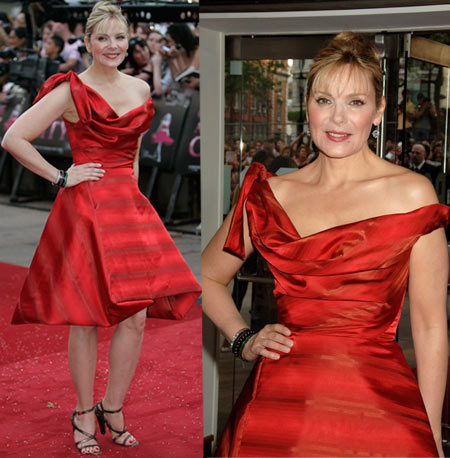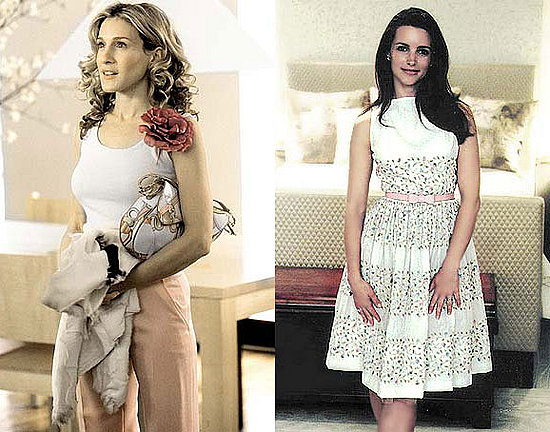
TEN years of watching “Sex and the City,” including the sanitized reruns on TBS, has trained a generation of label- and love-addled romantics not to raise an eyebrow, presuming Botox hasn’t yet made that impossible, when Carrie Bradshaw dons a black Burberry coat and a trilby to go shopping, film noir style, at Duane Reade. Or when Carrie wears a four-figure Nina Ricci sweater trimmed with hundreds of feathers while typing on a laptop in the privacy of her own home. Or when Carrie crawls into Big’s big bed, wearing makeup and a single strand of pearls.

With fashion, as with sex, fantasy is far more aesthetically pleasurable than the reality of, say, Alex McCord in “The Real Housewives of New York City.” As far as fantasies go, “Sex and the City,” as a series on HBO, was to fashion what “Hotel Erotica,” on Cinemax, was to sex: unbelievably plastic porn, without all the messy bits or the credit card bills.

In the film version of “Sex and the City,” which opened on Friday, the fashion is jaw-droppingly fantastic, Herbal Essences good. In two recent screenings in New York, the audience reacted most vocally — there literally was moaning — when Carrie, played by Sarah Jessica Parker, discovers that Mr. Big, her noncommittal boyfriend, played by Chris Noth, has built her a walk-in closet with carpeting and flattering lighting. She hangs a single pair of $525 Manolo Blahnik shoes there as a dog would mark its territory. (Oddly, this was not Mr. Blahnik’s best effort, unless he was inspired by a foot fetish that involves blue leprechauns.)

In the television series, broadcast from 1998 to 2004, fashion — the industry, the designers, the clothes — was a regular character, cleverly manipulated by the stylist Patricia Field to refine the personalities of Carrie (whimsical, eclectic), Miranda (independent, biting), Samantha (racy, sensational) and Charlotte (preppy, endearing).

Each character was bestowed with an individual style so distinct that women could identify with one of them. They could then buy a $39.99 T-shirt at the HBO gift shop to announce, “I’m a Carrie!” (for lovelorn philosophers) or “I’m a Samantha!” (for narcissistic man-eaters).
But in the film the characters are now four years older and, in a disappointing way, their styles appear to have changed into one: the offbeat, orgiastic, do-it-yourself madness of Carrie, the dominant female. It is not only that they now dress alike. In every scene the women are practically coordinated by both color and style, as if they had received a morning memo detailing the day’s dress code. Let’s all wear primary colors to a jewelry auction! Let’s all wear psychedelic hippie dresses on a trip to Mexico! Let’s all wear smart black-and-white ensembles and fur coats to a fashion show!
Sometimes the clothes even match the scenery, as when Miranda wears a droopy yellow turtleneck keyed to the blossoms in Central Park, or when Carrie, reading a copy of “Cinderella,” wears a sailor’s top with red stripes, which echo the dangling legs of a stuffed toy bug on a shelf behind her.
Now middle-aged, the women seem to be mellowing. As Carrie says, their 20s were for having fun, their 30s for learning from their mistakes and their 40s for buying the drinks. They are still enthusiastic cheerleaders for fashion, but they don’t seem so overcome by a dress.
Instead, they struggle with losing their identities, as they transition to coupled lives, to single lives and back again, to life on the Left Coast or to life as a mother. Fashion is the metaphor for the struggle. In Samantha’s case, this is represented by a fancy diamond ring that she wanted to buy as a symbol of her success, but it takes on new meaning when it is given to her by a man. Miranda, meanwhile, seems desperate to establish any sort of personal flair by wearing grossly oversize earrings, one pair dangling like ninja stars, another like serving spoons.
It’s easy to bash the show’s over-the-top materialism, but “Sex and the City” has never bothered to rationalize it, no matter how absurd or overpriced an item may be. (Nor has the show explained how a freelance writer could afford all those clothes.) It simply accepts that fashion is good and assumes the audience, just like Carrie, so badly wants to be a part of Vogue.
Yet, to the credit of Ms. Field and Ms. Parker, the film rarely bothers to identify the labels worn by the actors during the never-ending fashion parade, never once mentioning Manolo’s surname (as if that were necessary). There are exceptions, as when Carrie wears several designer wedding gowns for a Vogue photo shoot and credits each during a voiceover, and in some painfully unfunny banter between Carrie and her assistant (Jennifer Hudson), a woman named Louise from St. Louis who loves Louis Vuitton.
For her big wedding scene, Carrie characteristically bucks convention and champions a dress by Vivienne Westwood, one of the most original and radical designers of the 20th century, and not one of the darlings — not Dior, nor Ricci, nor Balenciaga — of today’s fashion elite. The gown is a showstopper, a frock so bubbly it looks like an overflowing glass of Champagne; in her hair, Carrie has affixed a turquoise-feathered bird. After this film, Westwood will surely be the new Blahnik.
Of course, labels appear every time a closet door or a Mercedes trunk opens, revealing an improbably neat display of shoe boxes and shopping bags from Dior, Gucci, Versace and, um, Bluefly. But part of the fantasy of the Manhattan high life is that women keep all the packaging because it’s so pretty. (O.K., O.K., so I store my tax returns in a box from Hermès.)
Whether these were product placements, a result of cross-marketing deals or just type-casting, the labels become as distracting as a lover with a tic — a lip biter or a navel licker. Wait. What? Did Charlotte just say she was pregnant while I was staring at the Gucci I ♥ New York bag sitting on the credenza?
The mention of a brand on the show has led to the success of several designers over the last decade, as Carrie Bradshaw represents the ultimate endorsement of a luxury system that is built on the aspiration to look rich or famous. Buying $1,000 handbags brings fulfillment. Buying knockoffs brings emotional impotence. Carrie can justify the extravagance of a wide leather belt with gold studs because, like Viagra, she can get a lot of mileage out of it, wearing the belt with a pink sheath dress one day and over the Burberry coat the next.
Nevertheless, “Sex and the City,” the movie, tries to undermine that message when Carrie hauls out a churchy, label-less skirt suit and declares, at one point, that this is going to be her wedding dress.